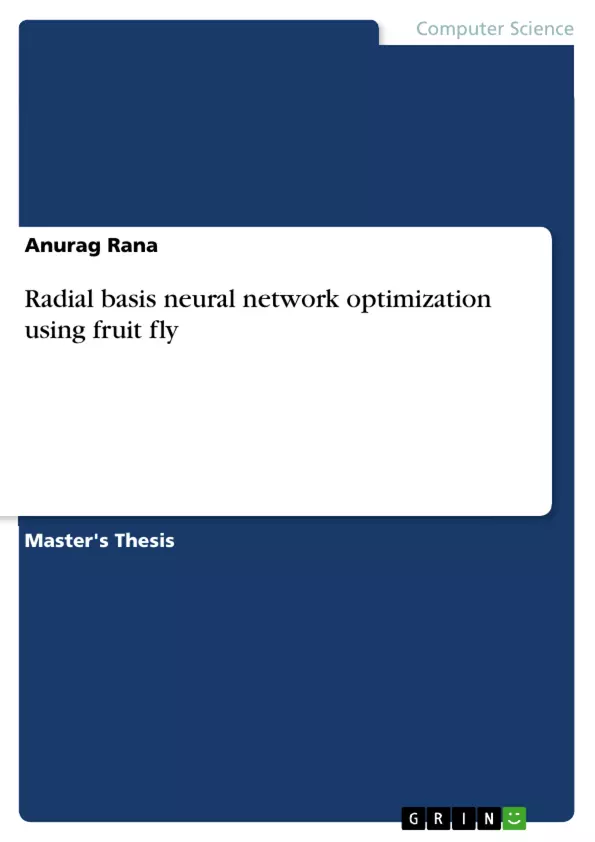This research presents the optimization of radial basis function (RBF) neural network by means of aFOA and establishment of network model, adopting it with the combination of the evaluation of the mean impact value (MIV) to select variables. The form of amended fruit fly optimization algorithm (aFOA) is easy to learn and has the characteristics of quick convergence and not readily dropping into local optimum. The validity of model is tested by two actual examples, furthermore, it is simpler to learn, more stable and practical.
Our aim is to find a variable function based on such a large number of experimental data in many scientific experiments such as Near Infrared Spectral data and Atlas data. But this kind of function is often highly uncertain, nonlinear dynamic model. When we perform on the data regression analysis, this requires choosing appropriate independent variables to establish the independent variables on the dependent variables regression model. Generally, experiments often get more variables, some variables affecting the results may be smaller or no influence at all, even some variable acquisition need to pay a large cost. If drawing unimportant variables into model, we can reduce the precision of the model, but cannot reach the ideal result. At the same time, a large number of variables may also exist in multicollinearity. Therefore, the independent variable screening before modeling is very necessary. Because the fruit fly optimization algorithm has concise form, is easy to learn, and have fault tolerant ability, besides algorithm realizes time shorter, and the iterative optimization is difficult to fall into the local extreme value. And radiate basis function (RBF) neural network’s structure is simple, training concise and fasting speed of convergence by learning, can approximate any nonlinear function, having a "local perception field" reputation. For this reason, this paper puts forward a method of making use of the amended fruit flies optimization algorithm to optimize RBF neural network (aFOA-RBF algorithm) using for variable selection.
Inhaltsverzeichnis (Table of Contents)
- Abstract
- List of Figures
- List of Tables
- List of Abbreviations
- Preface
- Chapter 1 Introduction
- Introduction
- Motivation and Aim
- Disposition
- Chapter 2 Artificial Neural Network
- Biological Neuron
- Artificial Neural Network
- Single Layer Perceptron
- Multi Layer Perceptron
- Artificial Neuron and Activation Function
- Linear Activation Function
- Non Linear Activation Functions
- Radial Basis Net
- Learning Methods
- Supervised Learning
- Unsupervised learning
- Neural Network Applications
- Process Control
- Speech Recognition
- Image Compression
- Medical Imaging
- Image Processing
- Face Recognition
- Road and Obstacle Recognition
Zielsetzung und Themenschwerpunkte (Objectives and Key Themes)
This thesis explores the optimization of Radial Basis Neural Networks (RBNNs) using the Fruit Fly Optimization Algorithm (FFOA). The main objective is to demonstrate the effectiveness of the FFOA in improving the performance of RBNNs for various applications. Key themes of the work include: * **Radial Basis Neural Networks (RBNNs):** Understanding the structure, learning mechanisms, and applications of RBNNs. * **Fruit Fly Optimization Algorithm (FFOA):** Exploring the principles and implementation of the FFOA for optimization problems. * **Performance Evaluation:** Assessing the effectiveness of FFOA-optimized RBNNs through various benchmark datasets and applications. * **Comparison with Traditional Methods:** Comparing the performance of the proposed FFOA-based RBNN approach with other optimization methods. * **Applications in Real-World Scenarios:** Investigating the applicability of the optimized RBNN model in real-world domains such as image processing, control systems, and pattern recognition.Zusammenfassung der Kapitel (Chapter Summaries)
**Chapter 1: Introduction** This chapter sets the stage for the thesis, introducing the concept of RBNNs and outlining the motivation behind using FFOA for optimization. It also discusses the disposition of the thesis and the organization of subsequent chapters. **Chapter 2: Artificial Neural Network** This chapter provides a comprehensive overview of artificial neural networks, starting with the fundamental concept of biological neurons. It delves into various types of ANNs, including single-layer perceptrons and multi-layer perceptrons. The chapter also explores different activation functions used in ANNs, focusing on both linear and nonlinear functions. Finally, it discusses various learning methods, including supervised and unsupervised learning, and explores the numerous applications of artificial neural networks across different domains.Schlüsselwörter (Keywords)
The primary focus of this thesis is on Radial Basis Neural Networks, Fruit Fly Optimization Algorithm, optimization, machine learning, artificial neural networks, pattern recognition, image processing, and control systems. This work highlights the potential of combining the strengths of RBNNs and the FFOA to achieve enhanced performance in various applications.
- Quote paper
- M. Tech. CSE Anurag Rana (Author), 2014, Radial basis neural network optimization using fruit fly, Munich, GRIN Verlag, https://www.hausarbeiten.de/document/275287


